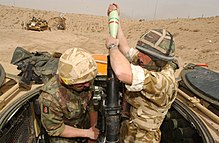Battle of Basra (2003)
To military and economic planners, it represents a strategic objective because it sits near a port that provides access from inland Iraq to the Persian Gulf.
British forces, unopposed, seized the city and surrounding area as a base for an advance towards Baghdad although the war came to an end before that occurred.
"[5][6] The population of Basra saw a dramatic increase in birth defects and childhood cancer during the 1990s; these illnesses and others were blamed on US depleted uranium munitions used in 1991.
[10] Spokespeople for the US military told the media that Basra's Shi'ite population would welcome the invading forces and rise up against Saddam Hussein.
[11][12] Among Iraqi cities, Basra "would be one that would fall quickly and would yield immediate photogenic results," said US military historian Raymond Callahan.
It would give a clear message to the regime—we have got your oil and commercial centre," said Colonel Christopher Langton of the International Institute of Strategic Studies.
[20] On the 24 March, Lance Corporal Barry Stephen from the 1st Battalion, Black Watch Regiment was killed when a rocket-propelled grenade exploded near his armoured vehicle in an action at Al-Zubayr, near Basra.
After a few days of combat, most of the invading American troops moved northwards, leaving Basra under a multi-week siege led by the British—considered better suited because of their past experiences in Iraq and Northern Ireland.
[13][25][26] A few members of D Squadron, British SAS, were deployed to southern Iraq to support the coalition advance on Basra, the team infiltrated the city and brought in strikes on the Ba'athist loyalist leadership.
[28] On the 24 March, the International Committee of the Red Cross announced that 60% of Basra's population had been cut off from clean water, and warned of a coming “humanitarian crisis”.
[29][30][31] Al Jazeera reported on the 27 March that Anglo-American forces had blocked the city's supply of drinking water, and were preventing the Red Cross from restoring access.
[34] Many actions were undertaken and the Red cross and British Royal Engineers co-operated in ensuring supplies were maintained even if they were reduced for a period of time.
A Center for Economic and Social Rights report claimed that the “Anglo-American blockade deprived one million residents of access to safe drinking water for almost two weeks”.
Meanwhile, UNICEF officials warned that "there are 100,000 children in Basra at risk for severe fever and death because one water treatment plant stopped functioning.
"[39][40] On 7 April, UK Secretary of Defence Geoff Hoon said he was “confident that the right balance [had] been struck” between avoiding civilian casualties and protecting Coalition troops.
Human Rights Watch reported:[45] U.K. forces caused dozens of civilian casualties when they used ground-launched cluster munitions in and around Basra.
At noon on March 23, a cluster strike hit Hay al-Muhandissin al-Kubra (the engineers’ district) while `Abbas Kadhim, 13, was throwing out the garbage.
Basra officials contested the use of these weapons, saying that depleted uranium used during the 1991 Gulf War was responsible for birth defects and cancer among the city's population.
They want it to go away because we kicked the crap out of them—OK?On the 28 March 2003, a US Fairchild Republic A-10 Thunderbolt mistakenly attacked and destroyed two British Scimitar reconnaissance vehicles in a "friendly fire" incident.
On the 24 March, there were reports of a major uprising against Ba'athist rule in the city but were suppressed by Republican Guard and Ba'ath Party militia; who were under the command of Ali Hassan al-Majid (a.k.a.
On 24 March 2003, 847 Naval Air Squadron provided transport and attack capabilities to ground forces while deployed to Camp Viking, Kuwait.
Whilst A, B and D company, 40 Commando, and the MSG (Maneuver Support Group) assaulted the suburb, Scimitars from C squadron Queens Dragoon Guards covered their advance, firing on Iraqi fighters bunkers and buildings.
The BRF captured the bridge across the waterway, which cuts off the suburb from the city and the surrounding villages east of it, after a firefight with 20–30 Iraqi soldiers who were either killed or retreated.
[62] British tanks and warrior-mounted infantry from the 7 Armoured Brigade entered the city center from the north on 6 April after repeated raids and shelling.
[65][66] It soon became obvious that the Iraqi defences were falling apart as Iraqi forces abandoned their positions, the brigade fought more than 300 militia at the College of Literature for 3 hours, eventually securing it, breaking the back of the Fedayeen resistance in Basra[66] Also on 6 April, 42 Commando, supported by a squadron of Challenger IIs from the 2 Royal Tank Regiment, and a Royal Artillery Forward Observation Team from 16 Battery, with support from 8 Commando Battery, assaulted the city from the south.
539 Assault Squadron RM and U.S. Navy SEALs attempted a waterborne approach to the city via the Shatt al-Arab waterway but were intercepted by Iranian patrol craft and withdrew to avoid engaging.
[67] In early April the British began a series of devastating yet limited raids against Iraqi positions using Warrior Armored Fighting Vehicles equipped with 30-mm cannons.
However, even after the fall of Basra, British troops occasionally came under small arms fire, whilst Marine bases were attacked by RPGs or mortars at night.
[78] In October 2003, the first Jaish al-Mahdi (JAM) units in Basra were established, which soon began low-level attacks against British troops and intimidated civilians working for the occupation forces.
[88] Doctors and environmental workers in Basrah had become aware of possible depleted uranium poisoning in the 1990s and begun remediation efforts; these were suspended when war broke out anew in 2003.


